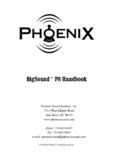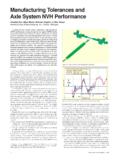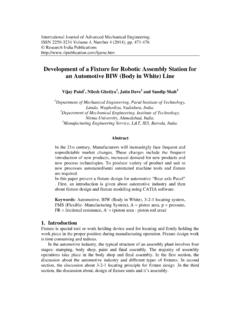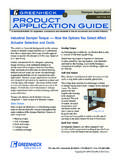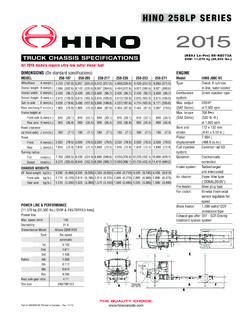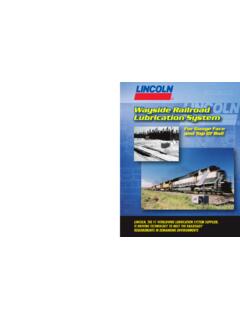Transcription of Bachmann K27 Installation Guide - Phoenix Sound
1 Bachmann K27 Installation GuidePhoenix Sound Systems, West Liberty RoadAnn Arbor MI : 800-651-2444fax: 734-662-0809e-mail: 2008 Phoenix Sound Systems, of 's Locomotive Features and Installation Optical Chuff Conventional Track Power Voltage Reed Switch and Axle Utilizing the Optical Using the Optical Chuff and the Smoke Digital Command Control (DCC/MTS).. Speed from DCC Reed switch and axle Speed from Optical Chuff Remote Constant track power, 2K2 - basic Constant track power, 2K2 - alternate Constant track power: PB9 Basic Constant track power: PB9 Alternate Constant track power: P5 & Battery Power: Battery Power: Battery Power: Airwire (Split Supply) and Airwire (Split Supply) and Airwire (Split Supply) and 2009- 2 -IntroductionBachmann once again brings you an ingeniously and meticulously designed locomotive that allows you to obtain excellent Sound realism to go along with the high level of accuracy and detail that are part of the Spectrum varies from easy to adventuresome depending on how you are powering the system and which of the Bachmann features you wish to use.
2 On the initial runs of the K27 there is no friendly way to pick up power. It is possible to install the Phoenix system without Installation of the speaker, volume switch, and the other components follows the general instructions in the regular Sound system manual. We have included some Installation pictures to help you with these aspects of the K27 's ElectronicsInside the tender you will find an early version of the G-Scale control socket. This is similar to the socket that is found in Aristocraft locomotives and the intention is that eventually you will be able to buy a receiver and Sound system of your choice, plug them into this socket and you're done. The socket design works best for systems that combine control and Sound on a single board. Phoenix systems are designed to work with DC, DCC and all the various control systems so we do not currently have a plug in configuration for this socket.
3 This manual will show you how to connect the Phoenix system utilizing and modifying the DC Dummy Plug In Board, diagrammed 2009- 3 -1 Locomotive Features and Installation DecisionsThe three main electronic systems that affect your control system and the Installation of the Phoenix Sound system are the Optical Chuff Sensors, the Smoke Unit and the Lighting circuit. It would seem that the Smoke Unit and the lighting circuit would not affect the Sound system Installation but you will soon discover that everything is related and life has in many cases not been made easy for the Optical Chuff of the cylinders has a light source and light sensor mounted in the middle of the cylinder. As the piston moves back and forth, the light beam is interrupted causing the "Chuff" pin on the socket in the tender to wiggle electrically but only a little bit.
4 Most Sound systems, including ours, cannot pick up on this small signal. Using the internal Optical Chuff sensor will involve adding a transistor to boost this signal up to a usable level. The optical chuff idea is a great improvement over the sprung brass contacts in previous spectrum locomotives. In its current implementation, it is not as accurate or reliable as a magnet and a reed switch though it might get there with a little more improvement. Every system has it's draw backs. The Optical Chuff sensor suffers three that we know moves before circuit is powered. The first problem only applies to DC operation (still a large percentage of the railroads we think). The locomotive starts to move before there is enough power to turn on the optical system . There are ways to address this and we will detail several in the appropriate sections.
5 Your choices are: a reed switch and magnets on either the rear driver or a tender truck axle. the motor starting voltage using diodes so that the chuff circuit is working when the engine starts to move. This may make double heading unfeasible if other similar locos do not use the same strategy. It will not work (as well) with pulse modulated track the Phoenix Sound board's 5 volt output to power the chuff circuit. [See smoke and lights] the motor voltage to determine Pulses. The second problem is that the pulses coming from the circuit are very short at high speed. Very short means that they are in the same neighborhood in duration as electrical noise that is prevalent in the circuit. This is aggravated by the low voltage swing. February 2009- 4 -This problem is addressed by adding filtering (a capacitor) that Bachmann did not realize they needed.
6 Also, the 2K2 system responds better to short chuff signals if the input is configured as active high instead of the standard active Quartered Properly. The chuff signals are not accurately timed with the rotation of the drivers probably due to manufacturing tolerances. This produces a noticeable irregular chuff cadence which some may decide is a feature but doesn't represent the way a real loco would Sound . This is most easily addressed with the Phoenix Systems by enabling chuff averaging. Note that chuff averaging works best if we can also see the motor voltage so we can distinguish between real speed changes and a chuff out of SmokingThere is a pin on the socket labeled smoke. It is actually a smoke enable which allows the power that is fed through socket pins 6 and 7 to reach the smoke unit.
7 This is important because we cannot power the smoke unit but we can operate the lights and chuff circuit. If the smoke pin actually fed the smoke unit we could power it separately and power the rest of the loco circuits from the Sound LightingThe headlight and rear light have separate pins on the socket. In the configuration where the Phoenix Board is powering the Chuff Circuit, additional circuitry is needed to preserve directionality since they are no longer connected to the track. The remaining lights (cab, marker, firebox) are on with loco power unless they are disabled by individual SummaryBachmann has tried to do it all. This has resulted in a somewhat complicated system with a lot of switches, wires and surprises. Once you figure everything out you should be in for a lot of high realism 2009- 5 -Control ConfigurationsThe three main control strategies are listed below.
8 Find the one that fits your railroad and proceed to the designated section of this TRACK POWER DCThese systems have no power on the track when the loco is not moving. This includes Train Engineer systems that transmit a control signal to a box that turns the track power up and down. For conventional DC control, you would want to use the Phoenix 2K2 Sound system which has a battery that is used to make Sound when there is no track power COMMAND CONTROL (DCC/MTS)This control strategy has power on the track all the time along with locomotive control signals. Each loco uses a device (decoder) between the track and the motor that allows power through to the motor based on the control signals. These systems can use either the 2K2 system or the P5. If you will always be operating under DCC, the P5 is your best choice.
9 If you will sometimes operate on DC layouts, you would want to use the 2K2 system . (The P5 will not make any Sound until the voltage is above 10 volts). You will also need to wire in the motor/lighting decoder of your choice sized for the locomotive and the loads it will be CONTROLIn this configuration, a receiver is mounted on the train and has power to it all the time either from batteries or from a constant voltage on the track. The control signals come through the air rather than the rails like DCC. Locolinc, RCS and Aristorcraft Train Engineer are the conventional control systems in this category. You can use either the P5 or 2K2 system . The P5 system in this application would normally include the auxiliary P5T board. This will read motor voltage and give you additional triggers.
10 (the P5 itself only has 2 triggers). With the extra board, the P5 system will still be less expensive than the 2K2 system . The P5 produces slightly less radio interference than the 2K2 system . Airwire is a hybrid wireless DCC system . They only support the battery configuration. Unless you already have a 2K2 system , you would normally use the P5. The P5T auxiliary board is not needed here because Airwire communicates with the Sound system using DCC 2009- 6 -2 Conventional Track Power DCIN EACH SECTION, WE WILL BEGIN WITH THE SIMPLEST Installation , WHICH IS VOLTAGE MODE, AND PROCEED TO COVER SPEED BY TRIGGERS. FOR DC OPERATION, YOU SHOULD BE USING THE 2K2 OR PB9 Sound BOARD. Voltage ModeIn this setup, the train speed is determined from the voltage on the track which for this hookup, is the same as the voltage on the motor.




